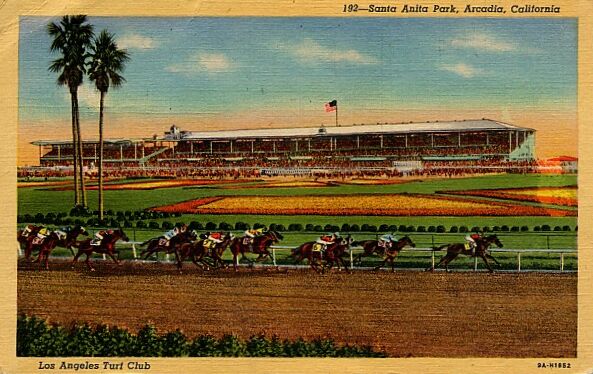
Editor’s Note: This is a guest post from James “Buzz†Surwilo (of The Uncle Buzz Workout, Tree Felling, and Homemade Maple Syrup fame) and his son, Doug Surwilo. This is not a sponsored post, though Buzz did get a free trip to California out of it, which, given the winter he has endured, should probably have been otherwise covered by his health insurance policy.
A couple of years ago, Brett wrote a post on horse racing. It was a sort of tutorial for the neophyte; why a man would want to go to the horse track for the first time, and what to expect when he gets there. Brett also rightly noted that the track is a perfect first date venue: it can be either cheap or high class (your choice), it’s full of excitement, there’s an at-hand subject for conversation, and, if things go well, usually you can find some out-of-the-way seats, or a shady spot beneath a tree, for snuggling.
Well, we’d like to suggest another type of outing at the track: a father and son spending quality time together.
As mentioned in Brett’s post, my dad — my son Doug’s grandfather that he never knew — would take us Surwilo kids to the track at an early age. Mostly to the now-defunct Green Mountain Park in Vermont, but we’d also usually end up at a race track somewhere on our rare family vacations. My father was the product of his times and the definition of old school: a WWII vet, glorified ditch digger, a man of simple means and tastes; he was happiest playing gin rummy with his buddies, or watching (and likely betting on) any ball game shown on our three-station TV. Pontificating about politics at the dinner table or gathering the progenies for a night at the opera were not in the offing. But piling a bunch of kids — unseatbelted, naturally — in the back seat of the car for a trip to the horse track, now that’s my dad.
Thus I grew up going with my dad to the track, which was even tolerable after I entered my sullen teenage years, when I thought my parents were as irksome and uncool as any two people could be. By that time I would usually grab a friend or two to go along, but going to the ponies remained a commonality between Dad and me until his untimely passing when I was in my 20s. My fondness for spending a day at the track was by then thoroughly cemented.
So, when I was invited a few weeks ago by America’s Best Racing to attend the Santa Anita Derby at Santa Anita Park outside Los Angeles, I jumped at the chance and decided to take Doug along. The timing was impeccable for two reasons. First, Vermont, where I reside, was even in early April enduring a winter for the ages, with only the feeblest signs of spring. In fact, the day before leaving for Santa Anita, I was out collecting maple sap on snowshoes to keep from sinking into knee-deep powder. So the vision of sun, short sleeves, and swaying palms had an unqualified bodily appeal. Second, and even more meaningful than a needed break from winter, Doug had taken a job and moved from Vermont to San Francisco not a week prior. 3,000 miles is quite a distance; I don’t have any idea when we will see each other again, so a day at the races — in California, of all places — takes on a certain poignancy.
I had followed my dad’s lead in first introducing my wife, and then my kids, to horse racing. The uninitiated might cringe, supposing that this was a direct path to perdition, but as Stephen Panus of the National Thoroughbred Racing Association says, “A day at the races is a long social event punctuated by sports.†Sure, there are the serious bettors, but for the people that I’ve been to the track with, including my son, it’s more about the shared experience; it’s a diversion from the routine, an interactive experience in good company. It’s not about the gambling, it’s about the gathering.
So I’d like to suggest an addition to this great list of father/son bonding activities: spending a day at the track together. (I bet your daughters will have a good time too.) Below, I’ll tell you about the experience Doug and I had, in the hopes of painting a picture for why you might consider planning such an outing for you and junior.
The Pleasures of a Day at the Track
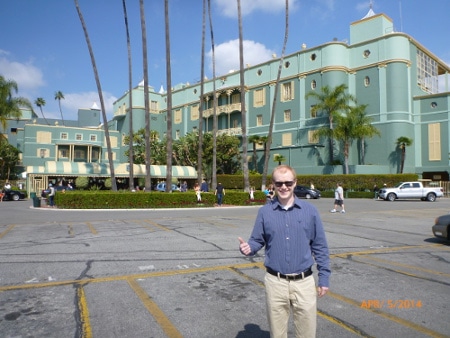
Doug at the track entrance with the very cool grandstand in the background.
So it was, that the first weekend in April, Doug and I found ourselves at Santa Anita Park, one of the iconic venues of the sport. The track was built in the 1930s in the Moderne architectural style, which I really dig. It has lots of curves in the design to give the impression of streamlined speed, and it’s painted in a cool blue and cream color scheme. Walking up to the grandstand through the impeccable landscaped grounds, we could feel the ghosts of movie stars and LA’s elite at our shoulders. Having never been to that part of the country before, Santa Anita just spoke Hollywood to us.
One thing that we love about the track is its egalitarianism. This is true of all tracks, but none more so than at Santa Anita that day: bow tied dandies, beautiful dressed-to-thrill women, hipsters, bikers, Brady Bunch lookalikes, geezers, Gen X, Y, and Zers, kids in strollers, and everyone in between. I doubt that you could hand pick a more diverse 35,000 people; it was as if a casting director said, “I want one of every type of American, and all having a good time.” There was a tangibly good vibe to the crowd that day and, as always, some excellent people watching.

Box seats at the track…doesn’t get any better than this!
We had box seats in the open air Santa Anita clubhouse, which is not our normal horse track habitat. We tend to sit with the plebeians — our peeps — in the grandstand or, like at Saratoga in New York, on one of the benches on the paved apron between the grandstand and rail. But, formally dressed for Vermonters (meaning that we both had on collared shirts), we effortlessly assimilated into the upscale clubhouse scene, relishing the elbow room, soaking in the spectacular view of the San Gabriel Mountains, and not having to worry that someone would glomp our seats when we went to bet.

Sampling the craft beer.
By great fortune, Santa Anita was having live music, a food truck exposition, and a craft beer festival in the track infield on Derby Day. Doug and I wandered out there several times to soak up the scene and try some craft beers that are hard to come by on the East Coast (and were $2 cheaper than at the concession stand…that’s like getting a free bet!). What a terrific atmosphere in the infield — many families picnicking on the lawn, with the kids having a blast on the expansive playground, people strolling around trying this and that from the myriad of food truck cuisines, a bunch of free cornhole courts set up, more beers than you could possibly sample in a week, and, at least while we were out there, the perfect live band for the occasion, covering just about every hit from the 1980s until now, with an irreverent front man who looked like Borat in short shorts and a Hawaiian shirt, but could get the crowd dancing. The infield had a completely different ambiance than the clubhouse; not better, not worse…what’s your flavor? Doug and I commented that we had the best of both worlds, and delighted in the contrast.
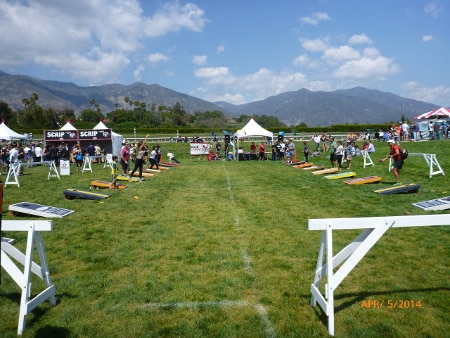
Cornhole with a view.
The Santa Anita Derby is one of the final prep races for the Kentucky Derby. It’s a chance for West Coast horses to show their mettle and earn points to qualify for the 20-horse Kentucky Derby field. And with a $1 million purse, it’s a big payoff for the winner. The Derby was the eighth of ten races that day, so the excitement and anticipation built throughout the afternoon. By post time the crowd was jazzed. The odds-on, and probably sentimental favorite was California Chrome, trained and owned by locals, with an appealing sort of rags-to-riches story. And the horse didn’t disappoint the hometown crowd, pulling away from the pack down the home stretch to win by over five horse lengths. Doug and I agreed that California Chrome seemed to be a man among boys out there, almost toying with the competition. Afterwards we commented that, given what we observed today, we may have watched the next Kentucky Derby winner in the flesh, and who knows, maybe the first Triple Crown winner in 36 years. Wouldn’t that be something?
Brett’s post of a few years back gave AoM readers the rudiments of betting at the horse races, and his personal tips for picking a winning horse. All of Brett’s pointers deserve weight, but like all amateur race goers, Doug and I have our own biases and strategies, as unscientific and debatable as anyone’s. Frankly, I don’t know if I am more successful at handicapping than the grandma two seats over who is picking horses by the color of the jockey’s silks, but I enjoy the mental exercise of sifting through the statistics presented in the Racing Form, and at least feeling as though I made an informed decision.
While Brett endorsed factoring in the jockey’s recent performance, Doug and I only give that a glance. I don’t go to the races, or any particular park, frequently enough to get a sense for the jockeys as individuals. Is this guy a few points higher in winning percentage because he happens to get good mounts, or because he’s a better jockey? Even Dale Earnhardt can’t drive a jalopy to victory lane at Daytona. I know that this theory goes against the thinking of a lot of railbirds — those guys who invariably stand next to me and refer to a jockey by their first name, as if they were speaking about their brother-in-law. “I’m glad they took Carl off. Leo’ll know how to handle that horse.†Is that so, pal?
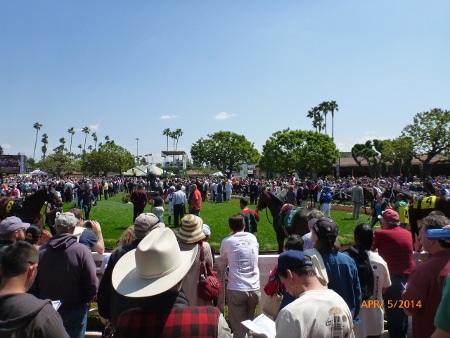
Joining the others that don’t know what they are looking at in the paddock.
I also don’t put much stock in my ability to discern a winner from observing the field of horses in the paddock, or walking in the post parade. You know what I really know about horses? Nothing. I’ve never even taken a pony ride. To me, all thoroughbreds look lean, muscled, and fast. And from my anecdotal experience, whether they are calm or excited, ears back or up, or take a pre-race crap or not, doesn’t translate to how they run when the gate opens. My unprofessional opinion, anyway.
Neither do I pay much attention to the odds, or how they fluctuate as the race approaches. I’m going to try to select the best horse in the race, regardless. Is a horse going to run any differently because it’s the longshot or favorite? I don’t think so. I think a lot of bettors want to make the big score and delude themselves that some horse with longer odds is an undiscovered gem and has a chance. If you are convinced that the super favorite (known as the “chalkâ€) horse can’t lose, but you don’t want to make $2.20 on a $2 bet, skip the race, get a hot dog, or buy your companions a drink. There will be plenty of other opportunities; don’t just look for the fast money and make a sucker bet against your own intuition.
Like Brett, Doug and I always bet — and better yet, cash in — with human tellers, rather than the automated machines. Not to start moralizing, but most of us could stand a little less time staring at a computer or phone screen and a little more talking face to face with a real person. And, as my mom would say about toll booth collectors, it gives somebody a job.
It’s human nature to opt for the shortest line available, be it at the grocery store checkout, the ridiculous airline security checkpoints, or the betting window at the track. I do it, too. But once in line, look at the queue ahead of you for these telltale signs of a long wait:
- A couple standing side by side. They will jointly step up to the window and start debating between themselves the merit of every horse in the race, what type of bet to make, and how much to spend, occasionally asking the stoic teller for clarification. After an excruciating five minutes, they will leave the window with a single, $2 show ticket for their efforts.
- A guy (or woman, no partiality here) who is constantly craning to see the tote board, checking the odds as the line moves forward. (See my take on betting based on the odds, above). The person will only decide what to bet when he or she is confronted by the teller, and, still turned towards the odds board, will do some mental gyrations, stumble, change bets, scribble on his or her program, and in all due time, cause steam to come out of the ears of the dozen people waiting in the line behind.
- A guy (usually a guy) who has enough handwriting on his race program to explain the origin of the universe, and is feverishly adding to and crossing out his chicken scratch as the line inches forward. Once he is finished giving the teller his complicated and oft-conflicting bets, the guy will look for the total in the ticket dispenser window before even thinking about extracting his wallet from his pocket and commencing to leaf through the bills, as if surprised that it costs money to wager.
- Seeing Doug or me ahead of you in line, because it’s guaranteed all these types of people will be in front of me!
The first question that people will ask when you return from the races is, “Did you win?†My father’s stock answer to my mother always was, “I broke even,†which ended the discussion without divulging any information, good or bad. So for the record, Doug and I broke even that day at Santa Anita. Honest. But I don’t go to the horse races expecting to win money, although that’s the hope, and always a bonus. As with Brett, I take only the money that I want to spend, same as if going out to dinner, or a concert, or the hardware store. So there is little distress in spending — not losing — my meager bank roll. Regardless of the final finances, I’ll have spent the day amongst friends or family, out of house, cheering, laughing, talking, and unwinding.
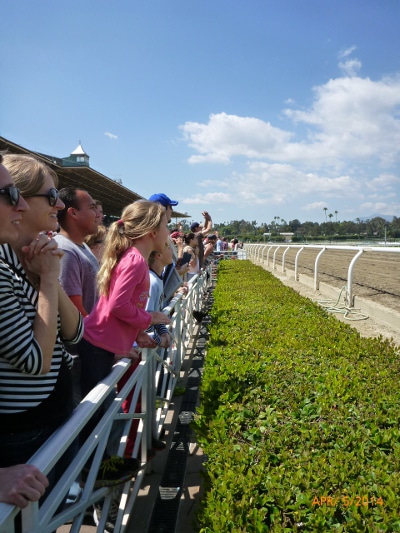
You get a wonderfully diverse crowd at the races — young and old, upscale and salt of the earth.
Americans love sports, and anytime there is a competition, especially when money is at stake, the energy of the onlookers, and competitors, is palpable. Horse racing is no different in that respect, but maybe it’s the leisurely pace of the program, a space that encourages freedom of movement, the organic nature of the sport, or the continuum of time-honored traditions, but there is a calming effect that compliments the enthusiasm of a crowd roaring as a dozen 1,200-pound animals thunder towards the finish line. With 25 or so minutes between races, there was plenty of time for Doug and I to converse — about the upcoming race, of course, but also about his new life in California, politics, philosophy, oft-told family stories, music, crude jokes, the meaning of life, and a hundred other topics. I can’t come up with a better setting for an open dialog with someone that you know, or want to know. I think that Doug and I have had an unspoken realization of this fact for some time, and we hope that you realize it, too. Take your son or dad to the horse races; neither of you will regret it.


